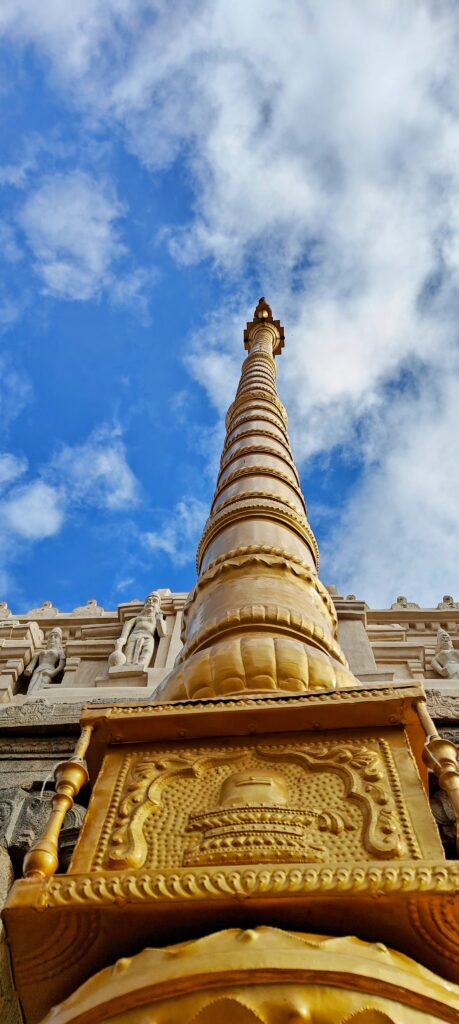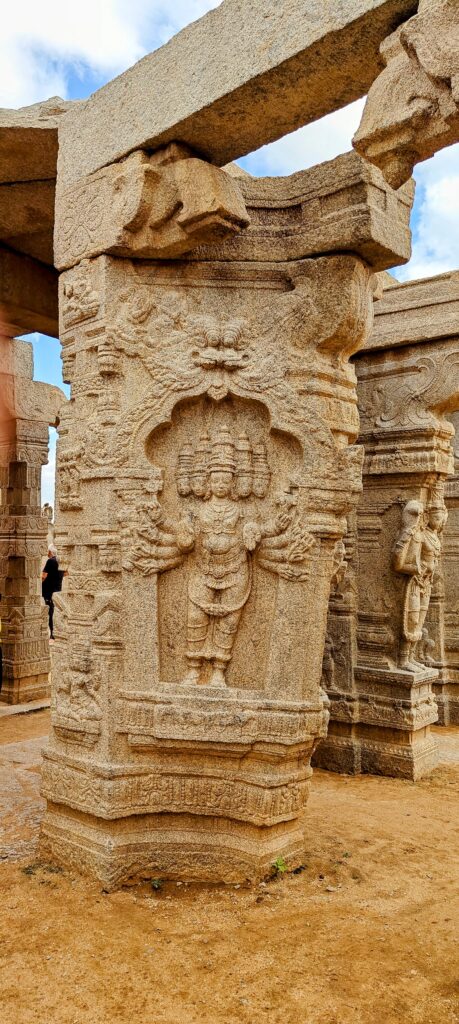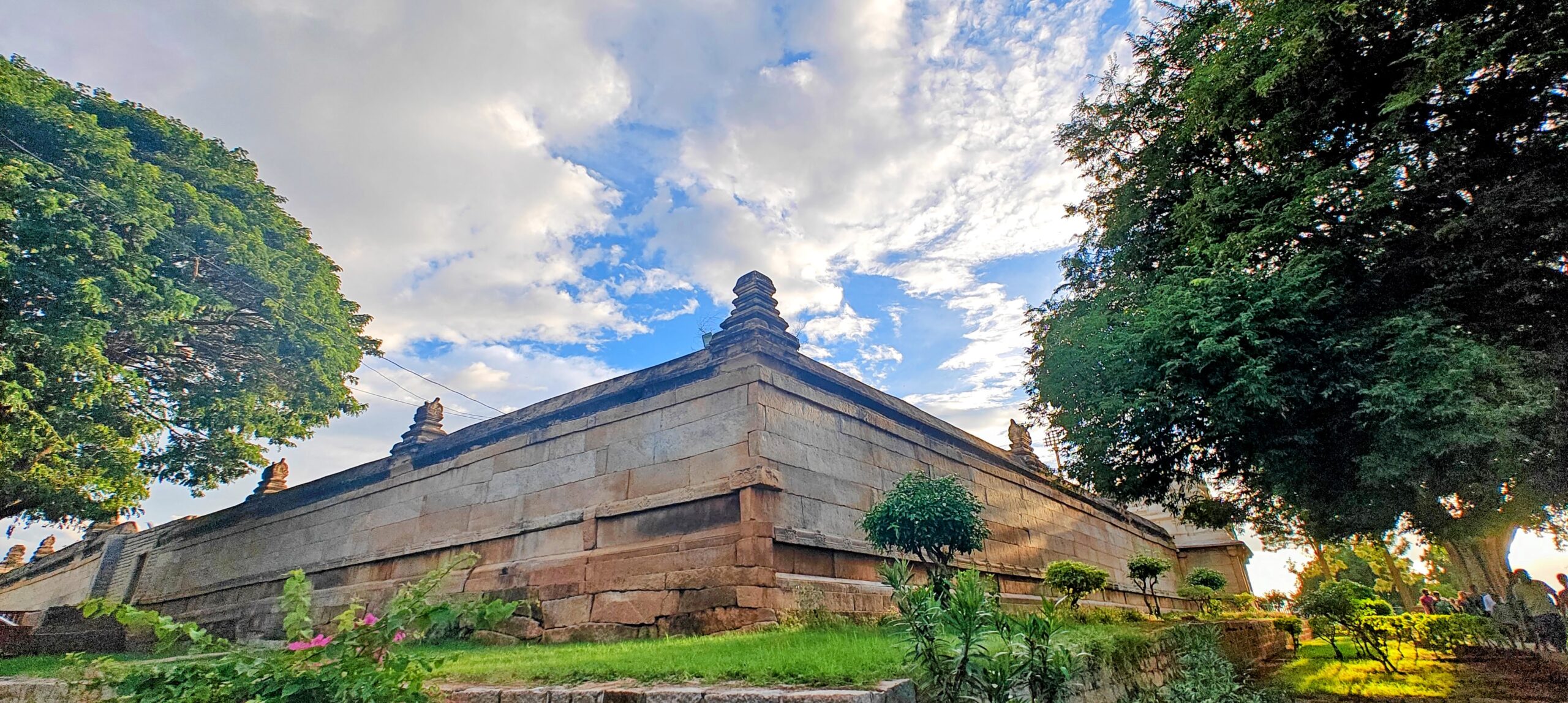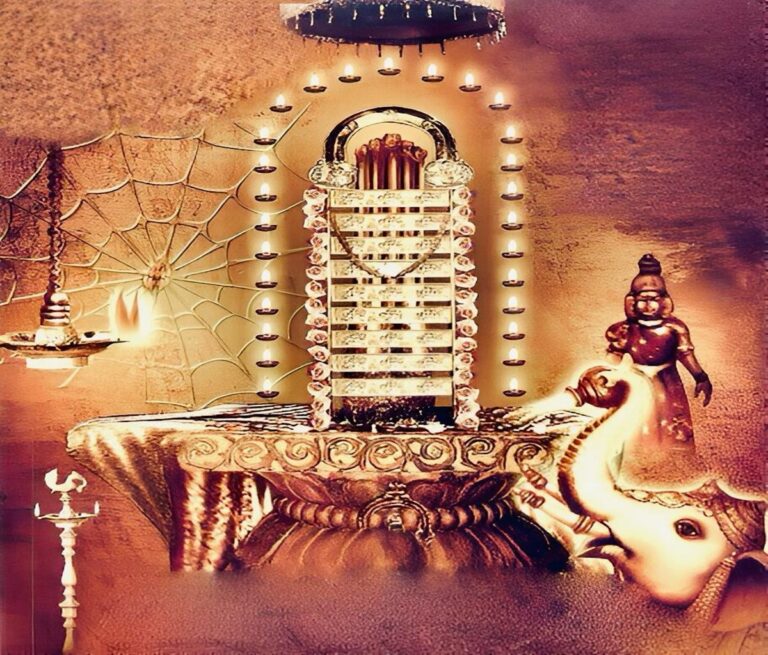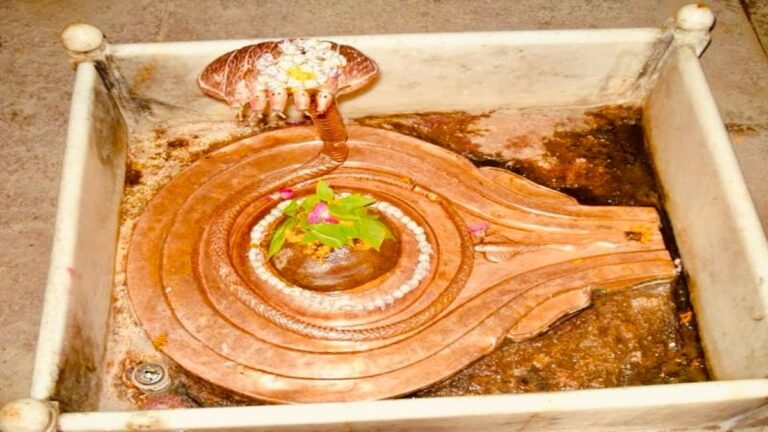My visit to the Veerabhadra Temple in Lepakshi was a very mesmerizing experience for me. I felt as if I have just stepped into a different era with the tall gopurams, and awe-inspiring carvings on the outside walls. Wandering through the temple complex, I was filled with appreciation for their work that reflects the age-long artistic traditions and skills of past generations.
Introduction to Veerabhadra Temple, Lepakshi
The Veerabhadra Temple is located in Lepakshi (Andhra Pradesh) and is a living example of the Vijayanagara Empire’s cultural richness and architectural brilliance. This temple is dedicated to God Veerabhadra, a fierce manifestation of God Shiva, and is very significant for devotees and historians. The construction was initiated by two brothers Viranna and Virupaksha, which proves the Vijayanagara empires commitment to art and culture. It was built between the 14th and 16th century.
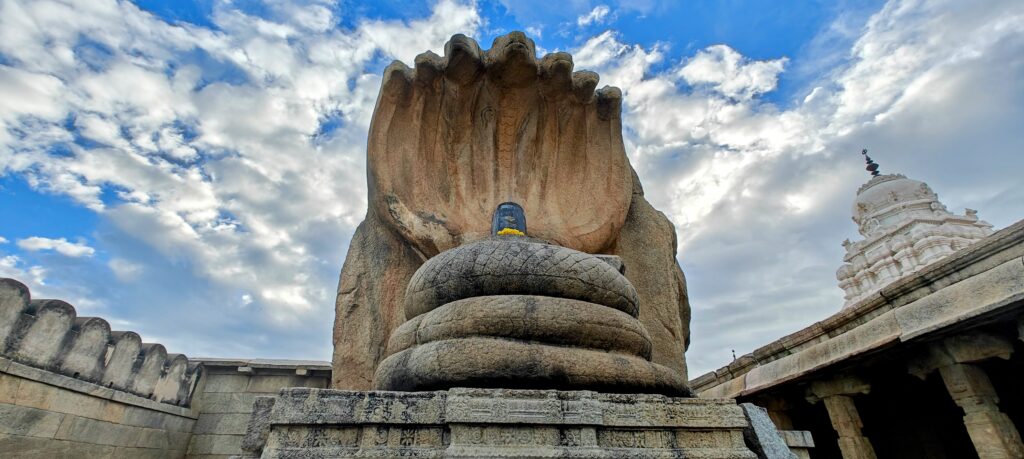
Quick Information
| Nearest Airport | Bengaluru (BLR) – Approximately 100 km |
| Travel Time from Bengaluru Airport | Approximately 1 Hour 30 minutes |
| Travel Options from Bengaluru Airport | Uber, OLA, Busses |
| Nearest Railway Station | Hindupur (Station Code – HUP) – Approximately 15 Kms |
| Travel Options | Private Taxi, Uber, Bus Service |
| Nearest Bus Station | Hindupur Bus Station |
| Temple Timings | 06:00 AM to 06:00 PM |
Historical Background of Veerabhadra Temple, Lepakshi
Hampi was the capital city of the Vijayanagara Empire, an essence of Hindu culture and architecture. Krishna Deva Raya the great king of the Vijayanagara Empire played a key role in the construction of this marvelous temple. It was during this golden era under him that the empire expanded its territories and the cultural revival was at its peak. It also shows the passion for spirituality and faith in Dharma, that the kings of that age had. The construction of the temple complex took decades of hard work, meticulous planning, and craftsmanship.
In the Skanda Purana, there are references to this temple (Lepakshya-Papanasanah). It is referred to as one of the 108 Divya Kshetras (major pilgrimage centers) dedicated to God Shiva. The name Lepakshi and how it was derived are described in several stories. In one of the stories, it is said that Jatayu (the Vulture Deity from the Ramayana) fought Ravana to save Sita Devi. Jatayu was injured and collapsed to the ground here. Rama, on seeing this, said the words ‘Le-Pakshi’ meaning ‘Rising-Bird’ in Telugu (the mother tongue of Andhra Pradesh and Telangana). Another story says that the name is derived from ‘Lepa-Akshi’ meaning ‘Embalmed-Eye’, which is highlighted in the paintings inside the Veerabhadra Temple.
The Vijayanagara Empire emerged to prominence in South India throughout the 14th century and was known for encouraging art, culture, and architecture. The great rulers Harihara I and Buka Raya I established the empire in 1336 under the spiritual leadership of their Guru, Vidyaranya. The empire of Vijayanagara was prosperous for nearly three centuries and Hampi was its capital city.
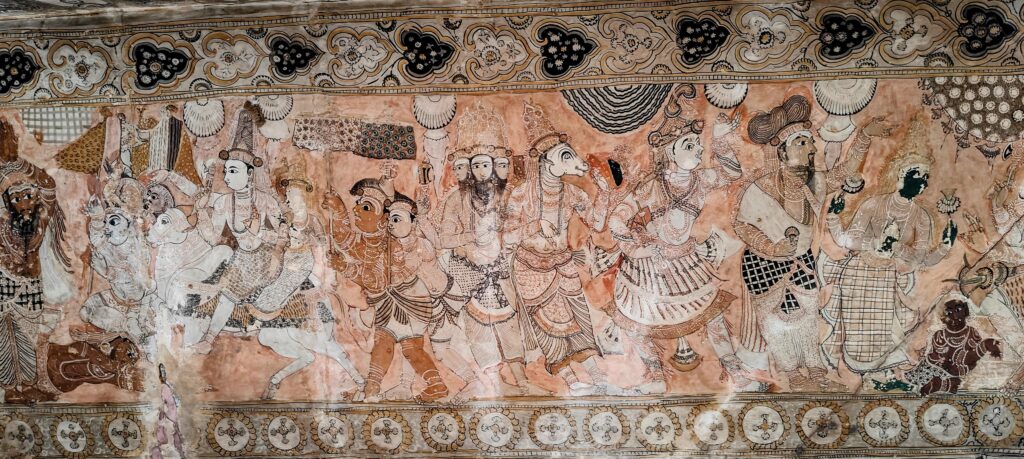
The Vijayanagara Empire’s prosperity and cultural growth were at their peak during the rule of Krishna Deva Raya. Historians claim that there was significant growth in literature, dance, music, and architecture and it is claimed to be a major achievement for Indian Culture. The paintings and carvings at the temple shows the commitment to the Hindu religion.
The temple complex did not just function as a place of worship for devotees but also was a hub for social gatherings, royal ceremonies, and educational discourses.
The decline of the Vijayanagara Empire started with the Battle of Talikota in the year 1565 and is considered to be a turbulent period in South Indian History. Despite the eventual decline of the empire, architectural marvels like Veerabhadra Temple still stand tall showcasing India’s rich cultural heritage and the spirit of its people.
Architectural Highlights of Veerabhadra Temple, Lepakshi
The Veerabhadra Temple Lepakshi depicts the Vijayanagara architectural style. The temple’s main sanctum is dedicated to Lord Veerabhadra. The Garbhagriha (Sanctum Sanctorum) features a magnificent idol of Lord Veerabhadra, which has been meticulously crafted and decorated that reflect the deity’s holy characteristics. The temple has three parts. The Mukha Mantapa (Assembly hall), the Arda Mantapa (Ante Chamber), and Garbhagriha (Sanctum Sanctorum).
One of the temple’s main attractions is the Hanging Pillar, which appears to be like the other 70 pillars in the area but does not truly rest on the ground. Locals enjoy demonstrating their specialty by passing newspapers beneath it, leaving visitors in wonder. The pillar is claimed to have been slightly dislocated from its original location, a flaw blamed on a British engineer who attempted to move it in a failed attempt to discover the secret of the architectural achievement. Another feature of the temple is a massive footprint carved into the stone. It is thought to be Sita’s, and its big toe is always full of water.
The temple complex has spacious courtyards (prakarams) and pillared halls (mandapas), which venues for religious ceremonies, cultural performances, and community gatherings during the Vijayanagara era. The Kalyana Mandapa, or the marriage hall, stands out with its carved pillars that depict scenes of celestial celebrations and mythological weddings, reflecting the importance of ritualistic ceremonies in ancient Indian society.
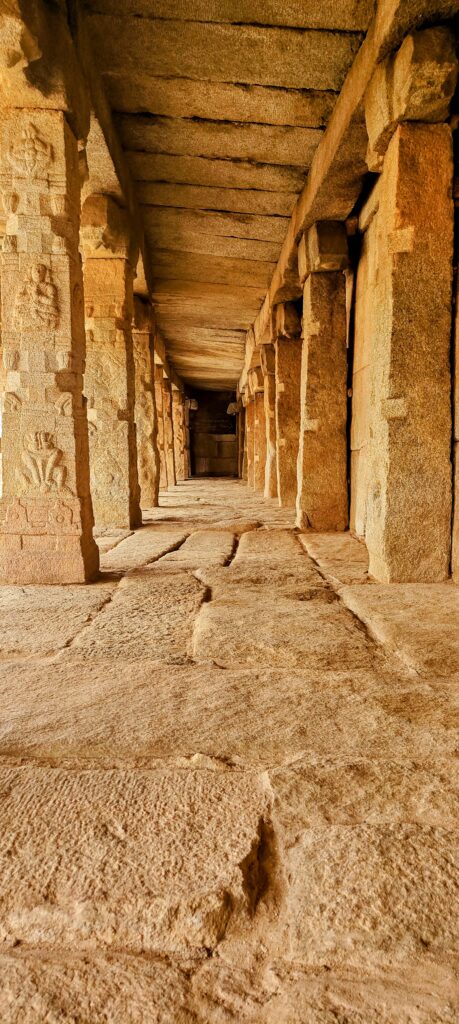
The central area of the ceiling features a painting of Lord Veerabhadra, painted by the temple’s builders, Virupanna and Viranna. It is most likely Asia’s largest mural, measuring 23 feet by 13 feet. There are additional images of at least 15 other Shiva avatars.
The incomplete open-air Kalyana Mandapa is thought to be the site of Shiva and Parvati’s wedding. According to folklore, the brothers Virupanna and Veeranna built the temple by embezzling cash from the treasury without the king’s permission. When the emperor apprehended them, he ordered them to be blinded, forcing them to quit their construction midway. There are rust-colored markings on a wall outside the Kalyana Mandapam that are thought to represent the scars left by the blood out of their eyes!
To the south of the temple is a Nagalinga crowned by a seven-hooded snake. Legend has it that the sculptors chiseled the serpent to pass the time while waiting for their mother to prepare lunch! A sculpture of Ganesha, as well as a serpent, spider, and elephant, decorate the linga.
A massive statue of Nandi, also known as Basavanna, is placed around 200 meters away from the temple. The seated bull is facing the Nagalingeshwara sculpture inside the temple. It is decorated with a necklace and a bell garland. It is the country’s largest monolithic stone statue of Nandi, measuring 15 feet in height and 27 feet in length. This huge monument is known among travelers for its precisely proportioned body, carved ornaments, and smooth outlines.
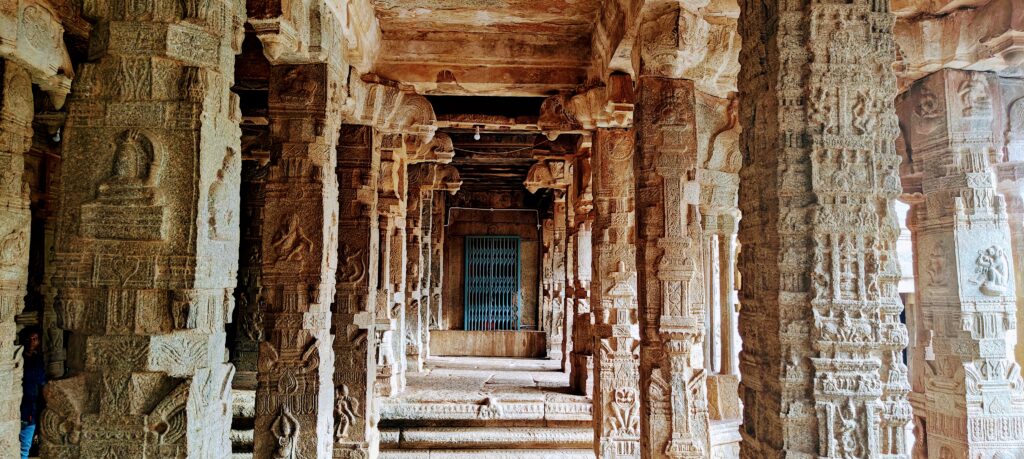
Religious Significance – Veerabhadra Temple, Lepakshi
It is said that the Veerabhadra temple Lepakshi is the place where God Veerabhadra was created out of the rage of God Shiva. The temples mythological beginnings create sacred environment that attracts pilgrims and those, on a quest, in search of comfort and blessings. The god with multiple arms and each arm holding weapons symbolises protection and the victory of good over evil. Devotees reach here to offer prayers and perform rituals to get blessings of God Veerabhadra for courage, strength, and spiritual enlightenment.
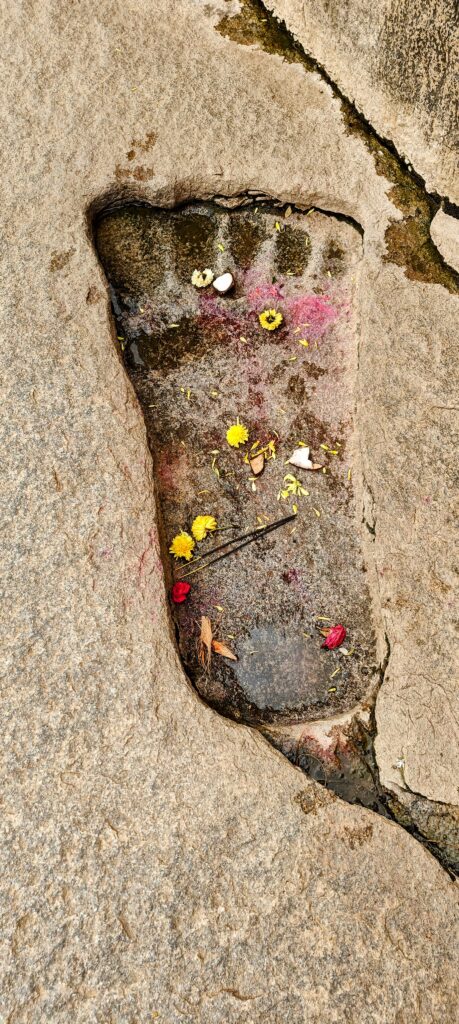
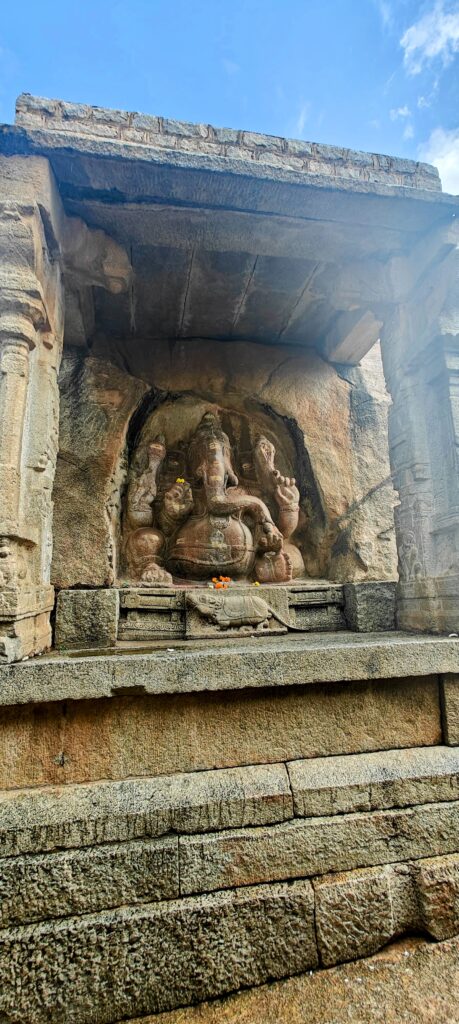
Visitor Experience
The Veerabhadra Temple is a place that allows you to experience the essence deep devotion and architectural beauty. I suggest getting in the morning to witness the temple awakening with the gentle touch of sunlight, on its aged walls. While exploring the temple take a moment to appreciate the details of the “hanging pillar ” a feat of engineering that still puzzles experts, with its unsupported structure. Each pillar and painting has a tale to tell! Inside the Garbhagriha (sanctum sanctorum) exudes an aura, where devotees offer prayers and rituals are conducted.
Conclusion
The Veerabhadra Temple in Lepakshi stands as an evidnce to India’s rich cultural heritage and architectural creativity. Its timeless appeal continues to attract visitors from around the world, offering a glimpse into the artistic brilliance and spiritual devotion of the Vijayanagara Empire. As you wander its corridors and contemplate its sculptures, reflect on the enduring legacy of ancient traditions and the enduring power of faith. Whether you seek architectural marvels, religious insights, or moments of tranquility, the Veerabhadra Temple invites you to embark on a journey of discovery and reverence that transcends time.
To know more about temples of Andhra Pradesh click here
